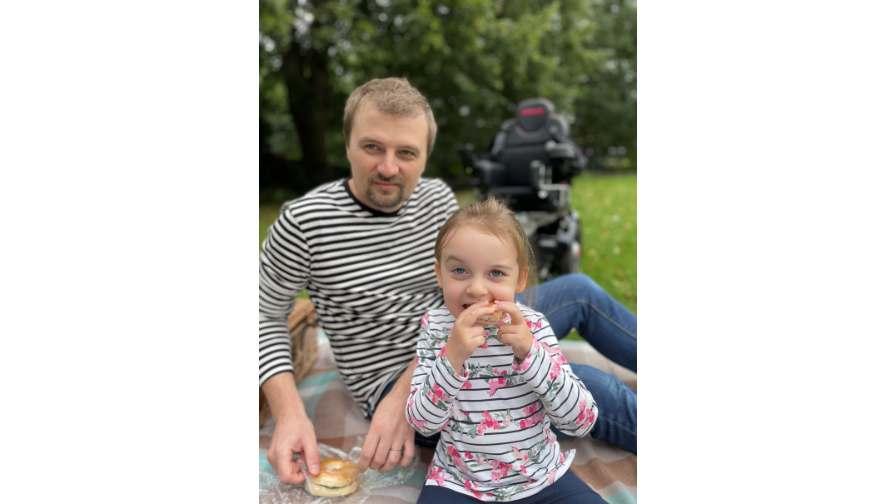Father of 9-year-old Sophia who has the rare and debilitating condition Spinal Muscular Atrophy (SMA)
Waking up between five to eight times a night for his nine-year-old daughter
This week is Father’s Day and we celebrate all fathers and father figures. If there was an award for ‘epic dad of the year 2024’, 44-year-old Gennadiy from Romford, Essex would be a contender. Gennadiy, whose nine-year-old daughter Sophia lives with spinal muscular atrophy type 1 (SMA type 1), wakes up five to eight times a night to ‘turn his daughter in bed’ as she cannot turn herself. Spinal muscular atrophy is a progressive condition that leads to loss of movement and muscle wasting. There is no cure, but gene therapy must be considered as a very powerful intervention, as well as Spinraza and Risdisplam. Tragically, babies born with the most severe types usually die at a very young age.

A heartbreaking first birthday diagnosis
Sophia was diagnosed with SMA a week before her first birthday after a series of tests. Sophia’s parents Gennadiy and wife Victoria had noticed that between the ages of six to nine months, Sophia hadn’t been reaching the usual milestones, as she did not sit, crawl and did not like being on her tummy. The diagnosis still came as a complete shock. Sophia was not expected to survive beyond the next 12 months. “We were told to take her home, love her, but don’t get too attached to her,” says Gennadiy – “as she is likely to pass away before the age of two”.
Against all odds
Sophia has just turned nine and due to a new treatment and her parents’ commitment, determination and fundraising efforts to purchase equipment including a wheelchair, Sophia has defied the odds. In 2019, the first drug for SMA called Nusinersen was approved. Nusinersen improves mobility and has vastly improved Sophia’s quality of life. Before this, Sophia’s health had been deteriorating, she had lost head control, the ability to move her arms and would frequently choke on her food. Having been almost paralysed, she has now regained strength in her hands and arms. She sits, plays and drives an awesome power wheelchair, goes to school and helps with advocacy for children through the Multi School Council as well as doing some part time modelling work. Sophia’s parents work hard to provide her with the best treatment and equipment, but they need support. “Our long-term plan is to offer Sophia at least a weekly session with private physiotherapist (more if funding allows) to enable the best possible rehabilitation process. We also have to buy physiotherapy equipment, hydrotherapy, and wheelchairs and build a dedicated physio space,” says Gennadiy.

An unknown but optimistic future
Although the new treatment has helped Sophia, it is not a cure and there are many challenges. Sophia recently had gene therapy, but it did not produce required results and so new treatments are needed as the existing treatment does not improve all symptoms. With the help of funding from Action and SMA UK, Dr Melissa Bowerman and her team at Keele University have successfully tested a new drug approach in the laboratory. Their previous work had shown that certain hormones involved in regulating the body’s metabolism are too high in SMA. The researchers discovered that using an existing drug that targets these hormones can improve SMA symptoms and that its effectiveness can be increased when combined with a current gene therapy treatment. Further work is needed but this gives hope of an enhanced treatment for children with SMA in the future. “We know that Sophia is alive today because of the new drug Nusinersen, but we welcome all new research into treatments for SMA as Nusinersen is not a cure. Waking up five to eight times a night and having to go to work the next day is hard, but I would do anything for my daughter. My hope is for new treatments and everything we need to improve the quality of life for Sophia, and people like her” says Gennadiy.
Dr Melissa Bowerman of Keele University says: “There is a real need to develop therapies that can support the gene-based approaches such as Nusinersen that are currently available for people living with SMA. However, these treatments do not improve all SMA symptoms and there is a need to identify additional ways to treat the disease. We hope that through our research supported by Action Medical Research and SMA UK we can improve outcomes for children with SMA by developing a new treatment that can be used alongside an approved gene therapy.”
Find out more: https://action.org.uk/research/spinal-muscular-atrophy-developing-potential-new-treatment.
